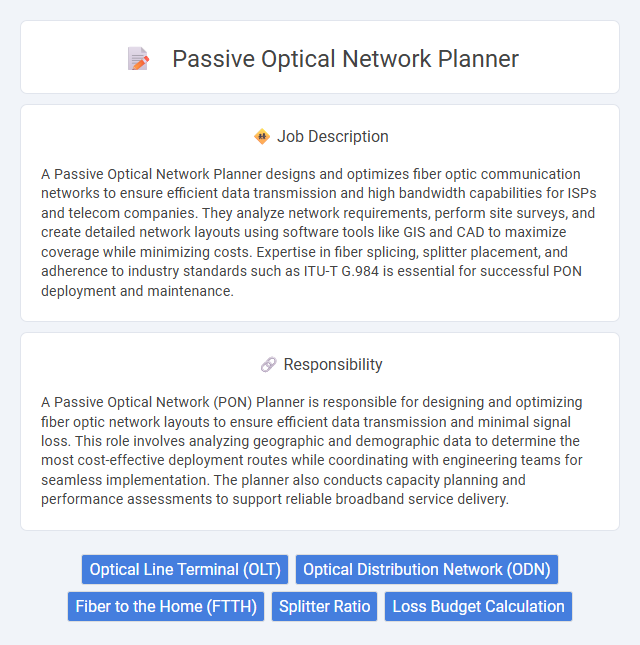
A Passive Optical Network Planner designs and optimizes fiber optic communication networks to ensure efficient data transmission and high bandwidth capabilities for ISPs and telecom companies. They analyze network requirements, perform site surveys, and create detailed network layouts using software tools like GIS and CAD to maximize coverage while minimizing costs. Expertise in fiber splicing, splitter placement, and adherence to industry standards such as ITU-T G.984 is essential for successful PON deployment and maintenance.
Individuals with strong analytical skills and attention to detail are likely suitable for a Passive Optical Network Planner role, as the job demands precise network design and optimization. Those who prefer structured environments and can work independently or collaboratively under tight deadlines may find this position fitting. Conversely, individuals who struggle with technical complexity or prefer less technical roles might find this job challenging.
Qualification
A Passive Optical Network Planner requires strong expertise in fiber optic technology, network design, and capacity planning, typically supported by a degree in telecommunications, electrical engineering, or related fields. Proficiency in CAD software and network simulation tools is essential for accurate layout and optimization of PON infrastructure. In-depth knowledge of industry standards such as ITU-T G.984 and experience with project management and regulatory compliance are critical for successful deployment and maintenance of high-performance optical networks.
Responsibility
A Passive Optical Network (PON) Planner is responsible for designing and optimizing fiber optic network layouts to ensure efficient data transmission and minimal signal loss. This role involves analyzing geographic and demographic data to determine the most cost-effective deployment routes while coordinating with engineering teams for seamless implementation. The planner also conducts capacity planning and performance assessments to support reliable broadband service delivery.
Benefit
A Passive Optical Network Planner role likely offers significant benefits such as enhanced expertise in fiber-optic technology and strategic network deployment. Employees may gain opportunities for career advancement within telecommunications infrastructure projects. The position probably supports skill development in cutting-edge network planning software and methodologies.
Challenge
A Passive Optical Network Planner likely faces the challenge of designing efficient fiber optic layouts that balance cost constraints with the need for high-speed, reliable connectivity. They probably need to navigate complex geographic and infrastructure variables while anticipating future network scalability. Managing coordination among multiple stakeholders and ensuring compliance with industry standards likely adds layers of complexity to their role.
Career Advancement
A Passive Optical Network (PON) Planner plays a crucial role in designing and optimizing fiber-optic communication networks, leveraging expertise in network architecture and signal propagation. Mastery in PON technologies, such as GPON and XGS-PON, enhances career advancement opportunities within telecommunications companies and infrastructure providers. Continuous skill development in network simulation tools and project management paves the way for progression into senior engineering and strategic planning roles.
Key Terms
Optical Line Terminal (OLT)
The Passive Optical Network (PON) Planner specializes in designing and optimizing the deployment of Optical Line Terminals (OLTs), ensuring efficient management of fiber optic networks. This role involves selecting appropriate OLT equipment, planning fiber splits, and mapping customer connections to maximize bandwidth and minimize signal loss. Expertise in OLT configuration and integration with network management systems is critical for maintaining service quality and network reliability.
Optical Distribution Network (ODN)
The Passive Optical Network Planner specializes in designing and optimizing the Optical Distribution Network (ODN) to ensure efficient fiber optic signal distribution from central offices to customer premises. This role involves detailed planning of splitter placements, fiber routes, and loss budgets to maximize network performance and scalability. Proficiency in ODN architecture, fiber optic technologies, and industry standards is essential for minimizing signal attenuation and enabling high-speed broadband connectivity.
Fiber to the Home (FTTH)
A Passive Optical Network (PON) Planner specializing in Fiber to the Home (FTTH) focuses on designing and optimizing fiber optic networks to deliver high-speed internet directly to residential customers. They analyze geographical and architectural data to strategize efficient fiber routes, ensuring minimal signal loss and cost-effective deployment. Expertise in split ratios, fiber types, and network topology is essential for enhancing network performance and scalability in FTTH projects.
Splitter Ratio
A Passive Optical Network (PON) Planner specializes in designing optical fiber networks with an emphasis on splitter ratio to optimize signal distribution. The splitter ratio, such as 1:32 or 1:64, determines the number of end-users served by a single optical line terminal (OLT), directly impacting network performance and bandwidth allocation. Accurate calculation and selection of the splitter ratio are critical for balancing cost efficiency and maintaining high-quality service in fiber-to-the-home (FTTH) deployments.
Loss Budget Calculation
Passive Optical Network Planners specialize in designing fiber optic communication systems by accurately performing Loss Budget Calculations to ensure signal quality and network reliability. This process involves evaluating all potential signal losses from fiber attenuation, splices, connectors, and splitters to optimize network performance within acceptable thresholds. Proficient knowledge of optical components and transmission standards is essential for precise loss budgeting and efficient network deployment.
 kuljobs.com
kuljobs.com